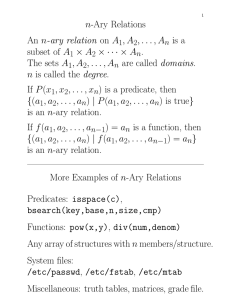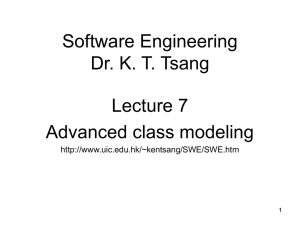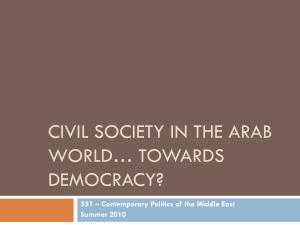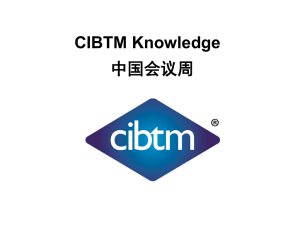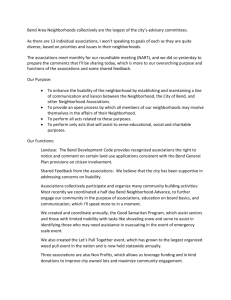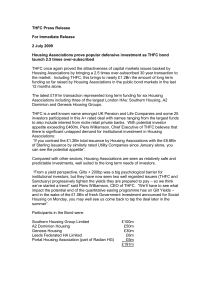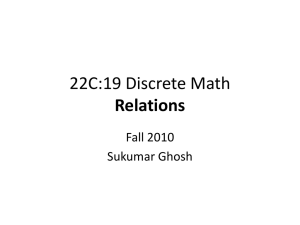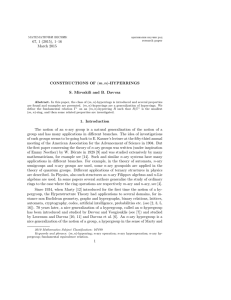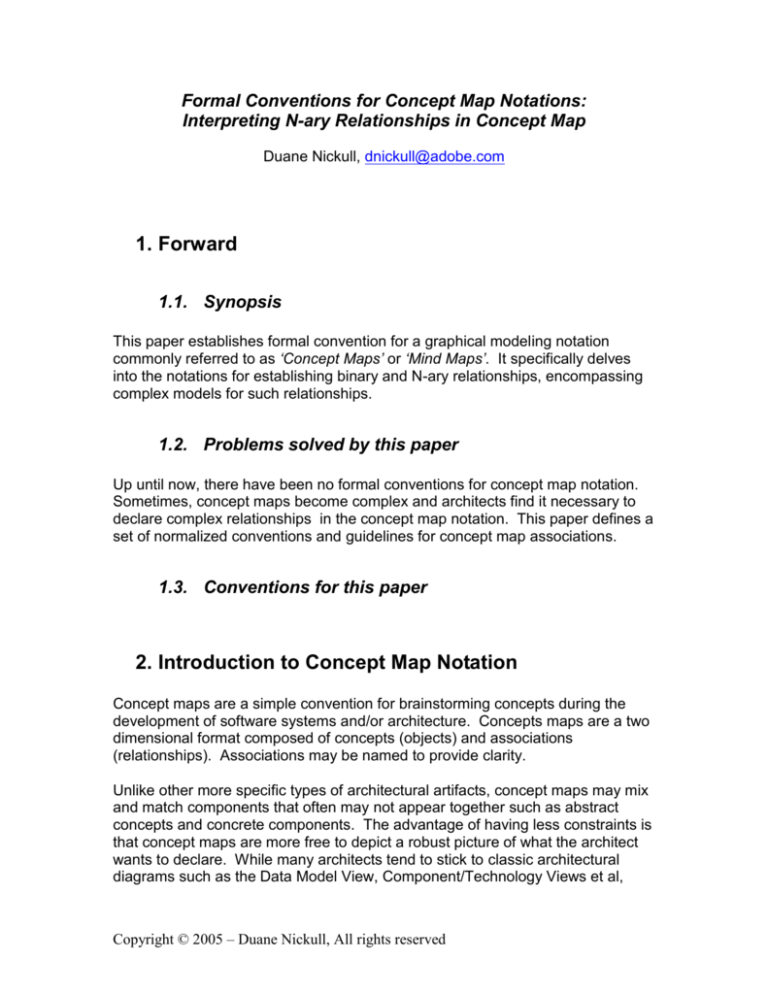
Formal Conventions for Concept Map Notations:
Interpreting N-ary Relationships in Concept Map
Duane Nickull, dnickull@adobe.com
1. Forward
1.1. Synopsis
This paper establishes formal convention for a graphical modeling notation
commonly referred to as ‘Concept Maps’ or ‘Mind Maps’. It specifically delves
into the notations for establishing binary and N-ary relationships, encompassing
complex models for such relationships.
1.2. Problems solved by this paper
Up until now, there have been no formal conventions for concept map notation.
Sometimes, concept maps become complex and architects find it necessary to
declare complex relationships in the concept map notation. This paper defines a
set of normalized conventions and guidelines for concept map associations.
1.3. Conventions for this paper
2. Introduction to Concept Map Notation
Concept maps are a simple convention for brainstorming concepts during the
development of software systems and/or architecture. Concepts maps are a two
dimensional format composed of concepts (objects) and associations
(relationships). Associations may be named to provide clarity.
Unlike other more specific types of architectural artifacts, concept maps may mix
and match components that often may not appear together such as abstract
concepts and concrete components. The advantage of having less constraints is
that concept maps are more free to depict a robust picture of what the architect
wants to declare. While many architects tend to stick to classic architectural
diagrams such as the Data Model View, Component/Technology Views et al,
Copyright © 2005 – Duane Nickull, All rights reserved
occasionally a concept map may be used to supplement the other formats and
provide a more cohesive view.
Figure 1 – a basic concept map
Each of the rounded rectangles above represents a concept. Concepts may be
considered abstract and may not have to be actual physical objects. A real world
implementation of a specific concept could be an object, element, process,
technical infrastructure component or it may not be implemented at all (if it is an
abstract concept, it cannot be implemented).
Concept maps may also mix and match abstract concept with concrete
components within an architecture. Such things might normally not co-exist in
other architectural views. The following exemplar illustrates an abstract concept,
a concrete object and an event and shows the relationships between them.
Copyright © 2005 – Duane Nickull, All rights reserved
Concept Conventions
Concepts are denoted by rounded rectangles. Concepts may have binary
associations with other concepts.
Names of Concepts should be expressed using upper camel case notation.
Generalized Associations
Concept maps use non-arrowed lines to depict associations between two
concepts. If a concept is associated to another concept and there is no arrow on
the line, the association is generalized and is of type Symmetric. This may be
depicted as follows:
Figure 2 – a symmetrical association between two concepts
The interpretation of the above concept map is an inference that “Concept A is
associated with Concept B”. The nature of that association is not specified. No
additional inference should be placed on the association.
Symmetric assocations have the following properties:
(<=> (Symmetric R)
(forall (?x ?y)
(=> (R ?x ?y)
(R ?y ?x))))
Variation – Weak Inference
In order to depict a weak or secondary inference, a dotted line may be used for
convention to depict an association that is not primary in nature. The convention
indicates that the concepts are related however the extent of the association is
not completely quantifiable.
Figure 3 – a generalized, weak inference association between two concepts
Copyright © 2005 – Duane Nickull, All rights reserved
In figure three, Concept A and Concept B are associated, however it is not clear
at this time what the extent, nature or dependency of that association is.
By convention, a black dotted line (not dashed line) should be used to denote this
type of association. This type of relationship is also always of type Symmetrical.
No name SHALL be used in a weak inference association.
3. Special N-ary Association Types
3.1. Coreflexive
(<=> (Coreflexive R)
(forall (?x ?y)
(=> (R ?x ?y)
(= ?x ?y))))
3.2. Named N-ary Associations
Symmetrical Binary Associations
If a concept is associated to another concept with a non-arrowed line and it has a
name, the nature of the association is open to interpretation. Accordingly, some
basic rules are applicable.
1. A named association is a specialization of a more generalized association;
2. If no arrow is present, it is a binary (two party) association and not a
unilateral association in nature.
Figure 4 – a specialized association between two concepts
In the figure above, Concept A uses Concept B and the inverse is also true.
There is equal weight applied to each of the two axioms:
1. Concept A uses Concept B
2. Concept B uses Concept A
Copyright © 2005 – Duane Nickull, All rights reserved
Asymmetrical Binary Associations
Another variant of the concept map convention is to depict a named, unilateral
relationship.
Figure 5 – a specialized, unilateral association between two concepts
The nature of the association in Figure 5 is that the named association is only
applicable in one direction and the reciprocal axiom is not true. This is quite
different from stating that it is unknown.
The following inferences are true in Figure 5:
1. Concept A loves Concept B
2. Concept B does not love Concept A
Visibility
As noted in the association above, an arrow also denotes visibility. In Figure 5,
concept A is not visible to Concept B. To rectify this, a Concept map employ two
specialized, unilateral associations.
Figure 6 – a specialized, multi-lateral association between two concepts
As illustrated in Figure 6, Concept A loves Concept B, however Concept B is
both aware of and also does not love Concept A. The following inferences are
true for Figure 6:
1. Concept A loves Concept B;
2. Concept B is aware of Concept A’s existence;
3. Concept B does not love Concept A
Visibility via Chained Associations
A circumstance may exist where there are more than two concepts and they are
related via several unilateral named associations. Each Concept map SHOULD
be as explicit as possible, without becoming overloaded with associations. It is
the responsibility of each Concept Map author to determine a suitable level of
detail for their audience.
Copyright © 2005 – Duane Nickull, All rights reserved
Figure 7 – a specialized, association involving three concepts
In the Concept Map example Figure 7, Concept C “invokes” Concept B AND
Concept B uses Concept A. One may infer from this there is a relationship
between Concept C and Concept A. Indirectly, there is however Concept C is
NOT visible to Concept A and inversely, Concept A is NOT visible to Concept C.
The following inferences may be made from Figure 7
1. Concept C invokes Concept B;
2. Concept B is not aware of Concept C (this may be confusing due to the
nature of the named association. “Invokes” clearly suggests that B should
be aware of who is invoking it. Be careful!;
3. Concept B uses Concept A;
4. Concept A is not aware of Concept B;
5. Concept C is not aware of Concept A;
6. Concept A is not aware of Concept C;
N-ary associations
N-ary relationship are supported in the concept map notation to provide
additional clarity.
3.3. N-ary Association Logic
AND, NAND, OR, XOR are all supported using the concept map notation.
AND N-ary Associations
AND relationships are assumed by default. In the exemplar below, there is no
need to additionally clarify that ((A is a parent of B) AND (A inherits from C))
since this is already declared.
Copyright © 2005 – Duane Nickull, All rights reserved
NAND N-ary Associations
Unlike AND N-ary associations, NAND N-ary associations must be explicitly
declared. The convention for doing this is to use a dashed line with a named
label value of “NAND”.
The exemplar above employs a NAND relationship. This can be interpreted as
Concept A may be either the parent of Concept B and have an unnamed
association with Concept C OR Concept A inherits from Concept C and has an
unnamed association with B but SHALL NOT have both at the same time.
It is important to note that this cannot be done by simply changing a the named
association from “inherits from” to “doesn’t inherit from” since this only expresses
one of the possible combinations rather than expressing the nature of the N-ary
relationships between A, B and C.
A NAND does not negate the fact that A is related to B and C, just the label. This
distinguishes it from “OR” which affects the relationship. If the association is
NAND, it is legal that A is the parent of B and A also has an association with C,
however that association cannot be of type “inherits from”.
OR N-ary Relationships
Copyright © 2005 – Duane Nickull, All rights reserved
OR logic is expressed using the same convention as NAND however uses the
label “OR”.
The OR convention is similar to NAND, however the both the base association
and the label are jointly at stake. In the exemplar above, Concept A may be
either the parent of Concept B OR inherit from Concept C. If A is the parent of B,
it MUST NOT have any further association with C and the inverse is also true.
XOR N-ary Relationships
Copyright © 2005 – Duane Nickull, All rights reserved

